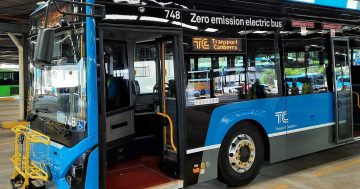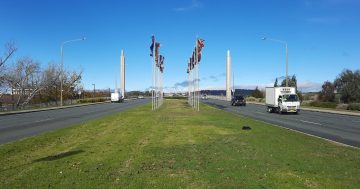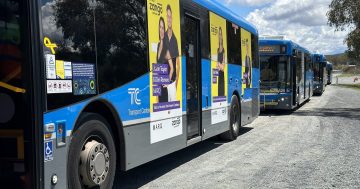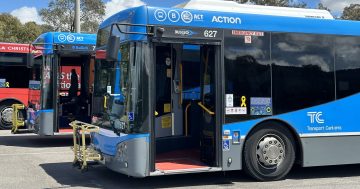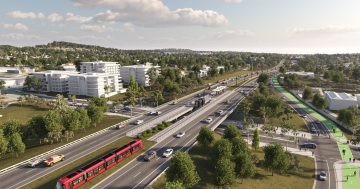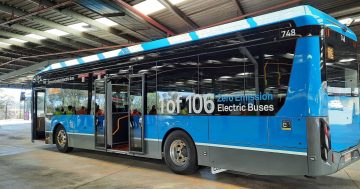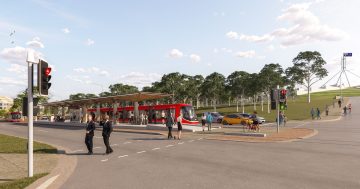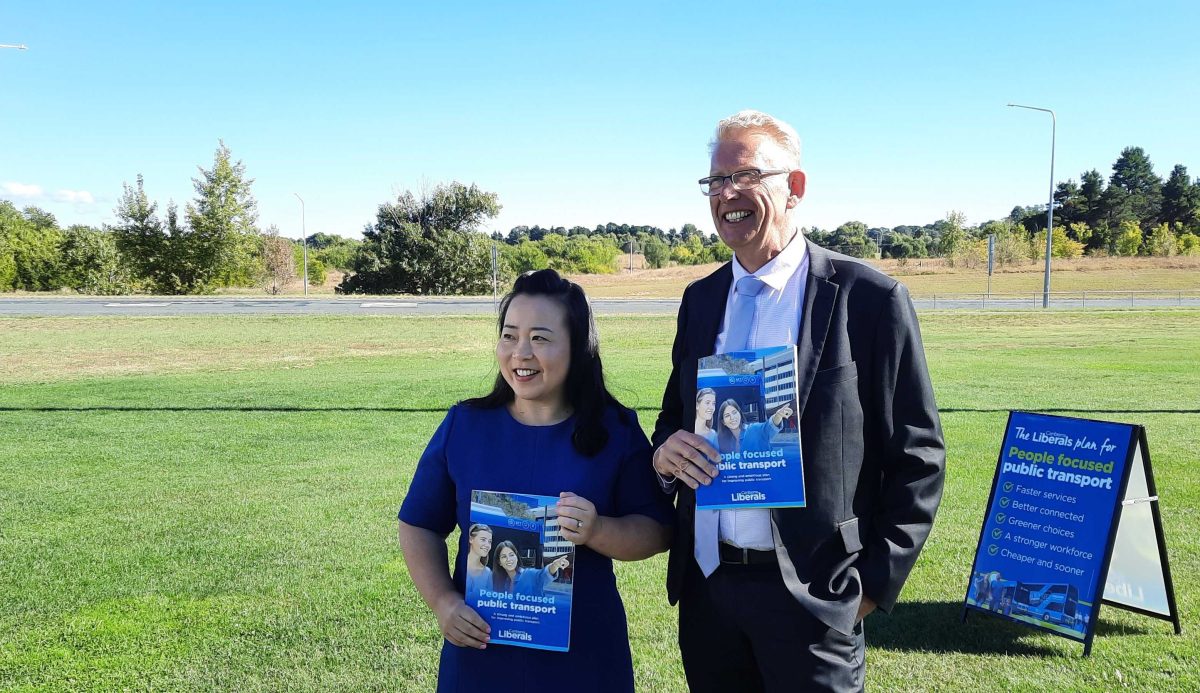
Opposition Leader Elizabeth Lee and Transport spokesperson Mark Parton: buses are a cheaper and more flexible solution. Photos: Ian Bushnell.
The Canberra Liberals’ bus-based public transport policy was a welcome plan to improve routes and services but failed to provide a long-term strategy for a mass transit system for a rapidly growing city, according to the ACT’s public transport lobby.
Public Transport Association of Canberra chair Ryan Hemsley said many of the measures could be found in the group’s 2023 ACT Budget submission.
But he said the policy was short on the details of how a Liberal Government would actually deliver faster bus procurement, move more people in peak time without adding to traffic woes, improve weekend services, and find the number of drivers needed for an increased number of services and more frequency.
“Many of those measures will deliver real improvements to Canberra’s bus network and are worthy of commendation,” Mr Hemsley said.
“It’s great to see more commitment to bus priority measures, specifically in Molonglo and Weston Creek, to bypass the bottleneck around Cotter Road.”
He also welcomed the commitment to legislate performance guarantees.
But Mr Hemsley said it was clear the Canberra Liberals weren’t interested in providing an answer to the question of how government planned for a Canberra growing by 100,000 people every decade.
“What they have proposed instead is a range of policies which will improve the quality of the bus network, but on the question of how we deliver a mass transit system for our growing city, it’s remarkably silent,” he said.
Mr Hemsley said that, at best, it was a medium-term response designed to provide an alternative to light rail to Woden.
But he warned the government not to be complacent because the Canberra Liberals had produced a comprehensive public transport alternative that would have a genuinely positive impact on the public transport user experience.
“The government can’t go into this election just to build light rail to Woden and nothing else,” Mr Hemsley said.
“They are going to be faced with an Opposition that has a comprehensive package that does provide a range of benefits no matter where you are in Canberra.”
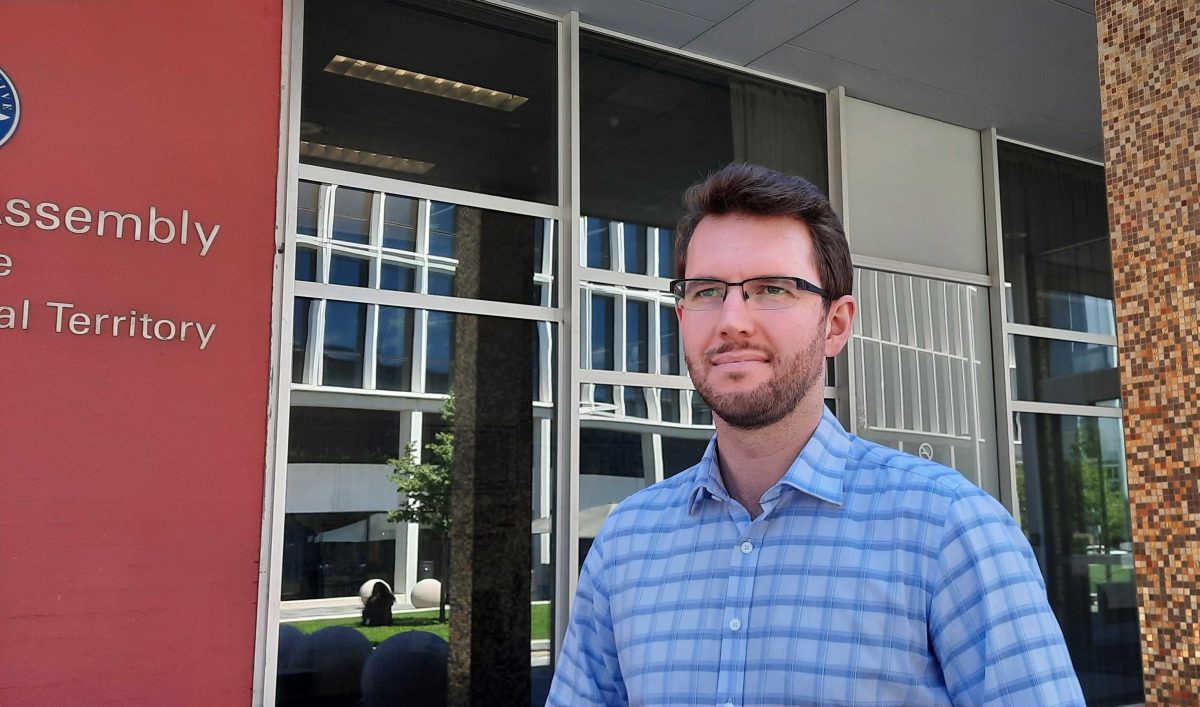
Public Transport Association chair Ryan Hemsley: The Liberal policy has many good elements, but it’s not a long-term plan.
He agreed that many voters would be attracted to a policy with shorter time frames and less expense, although the Liberal policy remains to be fully costed.
However, questions remained about how the Liberals would avoid the same procurement and construction barriers facing the government as it set about expanding the fleet to 500 electric buses and building the Belconnen and Woden busways.
Mr Hemsley was also puzzled about how the proposed busway on State Circle East would interact with the proposed Barton station near the expanding public service presence in that area and how adding potential stops along Yarra Glen and Adelaide Avenue would still mean faster travel times.
However, Canberra Liberals transport spokesperson Mark Parton said Canberra could not afford light rail and that an expanded electric bus network would meet the city’s needs.
He said the combination of more services, greater frequency, priority lanes and fare caps would attract more people onto the buses and out of their cars, freeing up the roads.
Mr Parton said the Woden to City route was the most successful in Canberra and would be even more so under the Liberals’ plan.
“You can already ride a bus between Woden and Civic in 16 or 17 minutes. We’ll get it down under 15 minutes,” he said, saying buses provide the flexibility that light rail could not.
“The priority bus measures that are outlined in our plan will facilitate that, and I would point out that the number of people that are currently moved on this bus route by buses, if you were to do it by a tram, would require a tram every three minutes, and they don’t have the rolling stock.”
Mr Parton said there would be a busway to Woden by 2027 and to Mawson by 2028, when construction was supposed to start on light rail 2B, with a 2033 finish date.
Opposition leader Elizabeth Lee said only a Liberal Government would have the will and commitment to clear procurement hurdles, deliver an all-electric fleet and recruit the drivers needed to run the network.
“It’s one of the reasons that we’ve announced the plan to go to market and actually get a bus manufacturer to set up operation here in the ACT to assemble buses in Canberra,” she said.
“Our view is … that the more things that you bring under your control, the more ability you have to actually deliver outcomes,” she said.
She said her government would still be looking to the Commonwealth to partly fund its plans.
Chief Minister Andrew Barr said the Liberal policy would not deliver the public transport network Canberra needed as it grew beyond half a million people in the next few years,” he said.
“This proposal is essentially doing the same thing over and over again and expecting a different outcome.
“We already have buses running on transit lanes from Woden to Civic.”
Mr Barr said Canberrans would see no housing benefits, job opportunities or economic gains that light rail had delivered for the city.
“The world’s greatest cities are not built on bus networks. They all have mass transit,” he said.
Transport Minister Chris Steel is still on leave.












